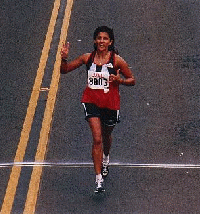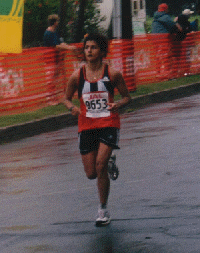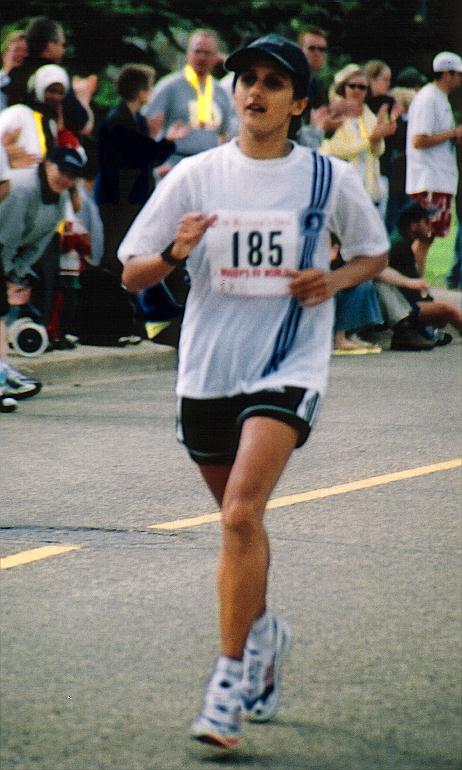| Runners are always concerned
with finding the perfect shoe. Once you
had found them, then it is easy to
replace them when they are almost worn
out. But what do you do when the
manufacturer discontinues your favorite
shoe, or changes the design, or you are
new to running and need to find the
proper shoe for you? There
are two types of running shoes: neutral
and motion control. What is best for you
is based on the mechanics of your feet.
The foot is designed to distribute the
weight of our bodies evenly while we
stand or walk. When we start running,
the pressure on your feet increases to
four - five times our body weight.
Obviously cushioning is vital as is the
proper fit.
If you have a regular
pronating or normal foot, you are usually
okay in a pair of neutral shoes with good
cushioning.
If you have a foot that
over-pronates, this is what happens: When
you run, the heel strikes properly on the
outside of the foot, but as you follow
through, the forefoot rolls in too much
towards the big toe. This puts stress on
the outside of the knee and other joints.
A motion control shoes corrects this
problem with a firmer midsole section
that keeps the foot from rolling to the
side.
The third type is the
supinating foot. Here the heel contacts a
surface on the outside of the foot, but
rolls out toward the little toe. Only 2 -
3 percent of the population fit this
category.
Selection tips:
1. Shop for shoes in the
afternoon or evening as your feet tend to
swell and widen as the day goes on.
2. Expect to spend $80 - $150
(CDN) for a decent pair of shoes.
Sometimes you might find a pair
discounted, but this usually occurs after
you have found your shoes. Don't worry
about purchasing an older model unless
the design has changed. Manufacturers
change colours every so often.
3. Men's shoes are designed
for people weighing more than 150 pounds
and women's shoes fit the 120 - 150 pound
category. They are also narrower in the
heel and wider in the forefoot.
4. Take your old running shoes
with you. This will help a salesperson to
see the pattern of wear thus indicating
what type of shoe will be best for you.
5. Wear the socks that you run
in to the store.
6. Try on more than one pair
for shoes.
7. A good running store will
access your gait to see if you need
motion control shoes.
8. The correct shoes should
feel comfortable with no pressure points.
9. You need a shoe with
adequate toe room. Check the length while
standing, not sitting.
10. Your heel should lift
slightly within the shoe, but it should
not move from side to side.
11. When you find your shoe
and the price is right, buy two pair and
consider storing one pair still in the box
in the freezer. This cold storage
prevents them from breaking down and
becoming rigid.
12. Running shoes can be
washed in a washing machine on the gentle
cycle. Set the temperature to cold and
stuff in a couple of towels. Dry them at
room temperature stuffed with paper towels
to retain the shape.
Good Luck and Great Runs
Gord - Women in Motion
|
         
FROM AROUND THE 'NET
1. What Happens to
Muscle When You Don't Exercise?
As we become older or more sedentary, fat
begins to slowly collect in the
muscles. The fat-saturated muscles reach their
limit and the fat
begins to accumulate outside the muscle
underneath the skin. We see
this in the "pot belly" of middle-age
men and the thickening of the
waist of middle-age women. If you diet, you will
lose the subcutaneous
fat (under the skin) but nothing will happen to
the intramuscular fat.
Your once lean and slim muscles will remain short
and round. You will
become a smaller version of the fat self.
However, you can exercise
away the intramuscular fat, resulting in the
return of the original
lean/slim-shaped muscles. Exercise will give
firmness and definition
to the muscle.
2. Will Exercise Develop Immunization to Disease?
The white blood cells are responsible for
fighting infection. Moderate
physical exercise will temporarily increase the
number of white blood
cells. After exercise periods lasting less than
30 minutes, the number
of white blood cells will return to normal within
one to two hours.
After exercise sessions lasting longer than 30
minutes, the white
blood cell count will remain elevated for 24 or
more hours. An
increased number of white blood cells suggest an
increased immunity to
disease and infection. Therefore, exercise makes
people less
susceptible to disease.
3. 6 Stages of Change
James Prochaska, PhD, in his book
"Changing for Good" (William Morrow
and Company, New York, 1994), has developed six
stages for change.
They are:
1. Precontemplation: Precontemplators have no
current intention of
changing. They have a feeling of hopeless, and
they use denial and
defensiveness to keep from going forward.
2. Contemplation: Contemplators accept or realize
that they have a
problem and begin to think seriously about
changing it.
3. Preparation: Most people in this stage are
planning to take action
within a month. Prepares develop a firm, detailed
scheme for action.
4. Action: This is the overt change of behavior.
The person takes
action and makes a commitment.
5. Maintenance: Often more difficult to achieve
than action,
maintenance can last six months to a lifetime.
6. Termination: The problem no longer presents
any temptation. Some
experts say termination never occurs, only that
maintenance becomes
less vigilant over time.
The key is to remember that change is a process
and oftentimes does
not occur without problems. It's important not to
get caught up in
self-blame for lapses but to use the experience
as help for future
experiences.
4. What is Leucine?
Branch-chained amino acids (the building blocks
of protein) are part
of the essential eight amino acids grouping,
which cannot be made in
the body but must be taken in daily through
dietary or supplemental
intake. This group of amino acids consists of
L-leucine, L-Isoleucine,
and L-valine. A deficiency in any one of these
amino acids will cause
muscle loss. Unlike other amino acids,
branch-chain amino acids are
metabolized in the muscle and not the liver.
In a recent report in the "Journal of
Nutrition" leucine,
found in protein-rich foods, can speed muscle
recovery after exercise.
For the person exercising at high levels,
researchers recommend
protein-rich foods such as energy bars, energy
drinks, or lean meats
as soon after exercise as possible. However, the
daily protein
consumption should be between 1.4 and 2.0 grams
per kilogram of body
weight. This is approximately 20 to 30 percent of
the daily calories.
Researchers do not recommend the use of leucine
in supplement form,
since the exact amount of leucine needed for
muscle recovery remains
unclear.
5. Sports
Drinks
Many people prefer sports drinks to water because
they taste better
and it's easier to drink them more often. If the
sports drink contains
a small amount of sugar, sodium, and potassium,
the drink will
effectively hydrate the person. The following
facts are important to
consider when using a sports drink:
- Sports drinks should contain between 14
and 19 grams of
carbohydrates per eight-ounce serving (six to
eight percent). A drink
with more than ten percent carbohydrates may
cause slow absorption,
nausea, cramps, or diarrhea. A drink with five
percent or less sugar
solution may not provide enough additional energy
to increase exercise
length.
- Carbonation causes stomach bloating. Dilute
carbonated drinks to
half-strength.
- The correct sodium level is 100-110 milligrams
per eight ounces.
Sodium content in sports drinks can range from
eight to 116
milligrams.
- Fruit juices have a 10-15 percent carbohydrate
level and need to be
diluted. Mix one part juice to seven parts water.
- As you do not sweat out vitamins; there's no need
to buy drinks that
include vitamins.
- Water is adequate for exercise under one hour.
However, if the
exercise is intense or lasts more than an hour, a
sports drink will be
beneficial.
- If you're participating in a sports event
lasting four hours or
more, you need a sports drink that contains from
110 to 120 milligrams
of sodium.
6.
Getting Rid of Stored Fat
There is a popular belief that obesity is the
result of overeating,
but that may not always be true. Research
indicates that in the United
States, obese people don't necessarily eat more
than normal weight
people. They are usually more sedentary,
resulting in the metabolizing
(burning) of fewer calories and the storing of
more adipose (fat)
tissue.
A normal individual has between 25 billion and 30
billion fat cells.
Most overweight North Americans suffer from
hypertropic obesity: The number
of cells is normal, but the size increases up to
40 percent from fat
deposits. When we lose weight, we do not lose fat
cells--they just
shrink in size.
Unfortunately when we have stored excessive fat,
it's hard to get rid
of it. The only factor that causes your fat cells
to release their
reserves is a lowering of glucose (blood sugar)
below a given level.
Individually, the fat cells will detect the
lowered glucose level and
begin to break down fat and release it into the
bloodstream as energy.
Moderate or even mild exercise can help you to
reduce glucose levels
by lowering the amount of insulin in the blood
and decreasing the
body's resistance to insulin. This enhances the
"fat-burning" ability
of the cells.
Remember to always check with your primary care
physician before you
start any type of diet/exercise program. A
physician can determine the
best methods for you to lose weight based on your
medical history. A
number of conditions, such as hypoglycemia,
diabetes, and glandular
disease, require specialized nutritional
plans.
7. Running Surfaces
Choosing the right surface to run on is as
important as choosing the
right running shoe. The key is to select surfaces
that will absorb the
shock rather than pass it along to the legs. When
changing from one
type of road surface to another, it's important
to be aware of the
dangers of each surface. Any sudden change of
surface could result in
injury.
The best surfaces for running are firm, flat,
smooth, and not too
hard. Generally, roads are acceptable surfaces
for running, but roads
have a gradual slope for water run-off. This
slope can cause feet to
over-pronate or over-supinate, depending on which
foot it is and the
direction of the slant.
Sidewalks are not a good surface for
running since concrete is about
ten times as hard as asphalt. Many of them have
uneven surfaces with
cracks and also require you to jump on and off at
every corner.
Grass is a great surface to run on as long as
it's flat and short.
However, if the grass is too long, it's difficult
to see ruts and
holes.
Trails are similar to grass and can be good
running surfaces. Watch
out for ruts and fallen branches.
Beach running can be very hard on feet, knees,
and legs. The beach is
slanted and forces your feet and legs to work
unevenly. If you run on
the beach, run at low tide when the beach is
flatter. Be sure to
change directions frequently.
Running tracks are very flat and firm but provide
some give, which is
ideal. However, some tracks are concrete under
the top surface, which
can result in adverse effects. Running on the
outside lane will help
to prevent injuries. Indoor tracks have a gradual
slant, so changing
directions frequently is important.
Indoor gyms and malls usually have a hard but
even surface. It's
important to wear well-cushioned shoes.
Treadmill running is great for the knees, legs,
and ankles. The
surface is very giving and is recommended for
post-injury training.
Words
of Inspiration
"When
it's pouring rain and you're bowling
along through the wet,
there's
satisfaction in knowing you're out there
and the others aren't."
-Peter
Snell, distance runner

Completion of Calgary Stampede Runoff Marathon -July 2.2000
3rd Female
The
Running Woman Message Board in Diet and
Fitness
The Running Woman
Message board continues to be active. The
number of posts have dropped back to the
usual 40-50 posts each week. Many of our
members are running marathons, 10K and 5K
runs. I have been a little slower
returning replies and writing this
newsleter as the commitment to getting to our local
runs and competition is time consuming. A large number of
new newbies
and wanabees have asked for help in
getting started. Thanks to all of you who
have provided assistance. Good Luck and
Continued Running to all.
Gord
The Runner's Club
The RUNNER'S CLUB is
still quiet, but with the number of
members increasing daily. We are still
having problems with incorrect
email addresses.This makes it difficult
to communicate with all members. If you
are a member, please take the time to
ensure that your email address is the one
you want to use.
A reminder that two
features of the CLUB still remain the
ability of members to communicate with
each other privately in the CLUB and the
ability to arrange to chat with each
other in the 24 hour chat facility.
Good Luck and Great Runs
Gord - Women in Motion
About This Newsletter
A reminder that experts
- we are not. Information presented here
is a collection of research with a taste
of experience and opinion added for
flavour. We don't get upset if someone
disagrees with anything that has been
said or written. In our experience with
running groups here at home, it is
difficult to get agreement on most
anything. If it works for you, then it
works.
Neither
Women in Motion nor the author of this
newsletter provides professional medical
advice. The information in this
newsletter is intended to help you better
understand running issues. It is not
intended to replace the advice of a
physician. If you read something in the
newsletter that contradicts what your
physician tells you in any way, always
follow your physician's advice.
SUBSCRIBE/UNSUBSCRIBE
INFO
You are receiving access
to this newsletter because you have
subscribed via Listbot. If you
do not wish to have future newletters
sent to you, please use that same system
found on the home page to unsubscribe.
If you have any
suggestions for topics or questions
please email us. We would like to publish
a monthly newsletter that reflects the
interests of the female runner.
Gordon Samson, Editor
Women in Motion
LEGAL
STUFF / SUBSCRIPTION INFO.
"Women
in Motion Newsletter" is free, but
its contents are
copyrighted. No one may use the content
without permission of
the author and "Women in
Motion". So please let us know if
you
think the information here is important
enough to be re-written.
Spread
the Word
Tell your friends they can get the email
link to this free monthly newsletter.
Gordon
and Fariyal Samson
Women in Motion
Visit us at
run.to/womeninmotion
Practice
doesn't make perfect, perfect practice
makes perfect.
-Fariyal
Samson, B.PE, B.Ed
 © Women
in Motion -July 6.2000 © Women
in Motion -July 6.2000
|
| |
|
|





